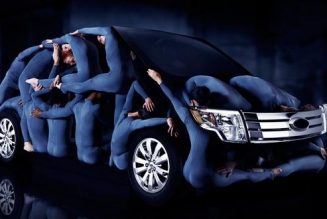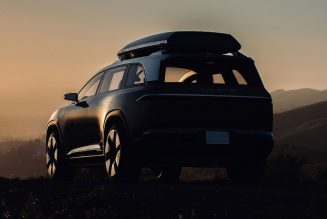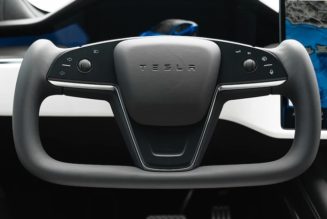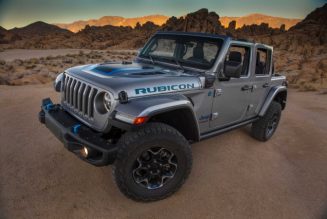Credit Subaru for unlocking the secret to selling station wagons to Americans in 1995. Faced with slumping sales at the start of the SUV boom, Subaru added plastic body cladding (and a suspension lift a year later) to the Legacy wagon, called it “Outback” and, as other manufacturers such as Volvo can confirm, the formula worked. With the new 2022 Porsche Taycan Cross Turismo, the German marque hopes the tactic will yield similar results for its performance-oriented all-electric station wagon.
How Separates the Cross Turismo From the Regular Taycan?
Similar to how the Tesla Model Y is basically a Model 3 with a minor suspension lift and a different roofline, Taycan Turbo Cross Turismo is pretty much a dual-motor all-wheel-drive Taycan sedan featuring a Gravel drive mode, standard air suspension, and minor ride-height increases.
Given that dual-motor all-wheel drive is standard, the powertrains predictably copy those of the Taycan 4 and Turbo models. With a permanent-magnet motor at each axle, the rear drives a two-speed automatic and the front a single-speed gearbox. The standard Taycan 4 Cross Turismo has 375 hp and 368 lb-ft of torque; the 4S model features 482 hp and 479 lb-ft; the Turbo packs 616 hp and 626 lb-ft; and the Turbo S spits out 616 hp and 774 lb-ft. All Taycan Cross Turismos come standard with Porsche’s big Performance Battery Plus, which has 93 kWh of capacity versus the 79 kWh standard on the Taycan sedan.
Porsche isn’t talking range yet; the EPA so far hasn’t certified the new wagon, but expect Turbo models to be rated for around 200 miles on a charge, and the 4 versions to net around 230 miles. Like all Taycans, the Cross Turismo can be fast-charged at up to 270 kW (20 kW greater than the quickest Tesla V3 Supercharger), which means the battery can go from a 5 percent state of charge to 80 percent in as quick as 22 minutes.
The rear end represents another difference between the Taycan and Taycan Cross Turismo models. The new wagon boosts rear cargo capacity from 14.3 cubic feet to 15.7, while the frunk remains unchanged at 2.9. Thanks to the new roofline, rear-seat occupants also get an extra 3.6 inches of headroom, while those in the front net a 0.3 inch gain. Porsche also offers a bespoke roof-mounted cargo carrier and a rear-mounted bike rack that plugs into two proprietary sockets in the Taycan Cross Turismo’s rear bumper.
Does It Drive the Same as the Taycan?
With only small mechanical changes between sedan and wagon, it’s unsurprising the new Taycan Turbo Cross Turismo feels much the same around town as the sedan version. With its 616 hp (which creeps up to 670 horses when you use launch control) and 626 lb-ft, the wagon’s power is—to crib from the Taycan’s largest rival—ludicrous.
The Taycan Turbo Cross Turismo explodes forward when you breathe on the throttle, at a pace few other station wagons—let alone sports cars—can match. And there’s a quicker version. Porsche says the Taycan Turbo Cross Turismo will accelerate from 0 to 60 mph in 3.1 seconds and cover the quarter mile in 11.1; the company says the Turbo S version will do the deeds in 2.7 and 10.7 seconds, respectively. What’s more, we expect Porsche’s estimates are conservative, based on our previous test numbers for a Taycan Turbo S sedan.
Although the Porsche Taycan Turbo Cross Turismo captures the sedan’s same explosive performance, there are some differences due to the suspension changes. The Cross Turismo’s 0.8-inch lift in its default ride height may be small, but it’s certainly noticeable. Around town in Normal mode, it feels ever so slightly flintier than the sedan does, as the air springs add ride height by inflating an airbag. This makes for a firmer suspension and a stiffer, less forgiving experience.
The suspension adjustments also negatively impact the otherwise fantastic ride and handling balance. Like a Dyson vacuum, a normal Taycan Turbo sucks itself down to the road, whereas the Taycan Turbo Cross Turismo in both Normal and Sport modes feels a bit more SUV-ish, with just a hint of lean and body roll. Thankfully, Sport Plus and Range modes seem to put its suspension back in its sweet spot, delivering the quick turn-in and planted feel you’d expect from a Taycan. (Scroll to the end for more details on the suspension’s various settings and differences between models.)
We didn’t have the opportunity to test the Taycan Turbo Cross Turismo’s Gravel mode off-pavement, but Porsche says it’s designed for “gravel tracks or muddy road surfaces.” Given the Cross Turismo’s 12.2-/12.0-/16.2-degree approach/breakover/departure angles, if you’re looking for more off-road capability from your electrified Porsche, a Cayenne E-Hybrid will likely serve you better.
How Much Is the Cross Turismo—and Is It Worth It?
Considering there’s no single-motor, rear-drive, small-battery, or steel-sprung version of the Taycan Cross Turismo, the new electric wagon is a bit pricier than the sedan version. Prices for the Taycan 4 Cross Turismo start at $92,250, $10,000 more than a Taycan. The price gap narrows somewhat for the rest of the lineup: The Taycan 4S Cross Turismo starts at $111,650 (versus $105,150 for the Taycan 4S), the Taycan Turbo Cross Turismo starts at $154,850 (versus $152,250 for a Taycan Turbo), and the range-topping Taycan Turbo S Cross Turismo starts at $188,950 (compared to $186,350 for a Taycan Turbo S). As with the rest of Porsche’s lineup, options add up quickly; our well-equipped German-market Taycan Turbo Cross Turismo likely stickered for around $195,000.
Is the 2022 Porsche Taycan Cross Turismo worth the premium versus the “equivalent” sedan models? It’s tough to say objectively without having had the opportunity to run the new electric Porsche station wagon through our instrumented testing; subjectively, though, the elongated roofline and attractive new profile make quite the case for it. As Subaru found some two-and-a-half decades ago, some cladding goes a long way in selling station wagons. For anyone shopping for a practical new Porsche, you’d be foolish to not at least consider the do-it-all Taycan Cross Turismo, Turbo, or otherwise.
More Info on the Suspension
Much in the same way the Tesla Model Y is basically a Model 3 with a minor suspension lift and a different roofline, the new Taycan Cross Turismo is pretty much a dual-motor all-wheel-drive Taycan sedan with the model line’s big battery pack, a Gravel drive mode, standard air suspension, and the most minor of ride height increases—just 0.8 inch for the standard Taycan Cross Turismo, or 1.2 inches for a Taycan Cross Turismo with the Off-Road Design package. The latter also includes most of the extraneous body cladding you expect from a lifted station wagon dressed up as a crossover SUV.
The ride height increase is interesting, as there’s much overlap between the Cross Turismo and standard Taycan when the standard version is optioned with Porsche’s PASM air suspension system.
A Taycan Cross Turismo without the $1,780 Off-Road Design package—like our pictured Taycan Turbo Cross Turismo test car—sits at the same ride height in its default Medium setting (used for both Normal and Sport drive modes) as the Taycan does in its Lift setting. With the Taycan Cross Turismo in its Low suspension setting (which is activated in both Range and Sport Plus modes, or selected in the Individual drive setting), its ride height is about the same as a Taycan sedan in its standard Medium setting.
Whereas the standard Taycan can drop an additional 0.9 inch in Range or Sport Plus modes, the Taycan Cross Turismo rises an additional 0.4 inch from its standard ride height in its High setting in Gravel mode or an additional 1.2 inches from its default height in its Lift setting. The Taycan Cross Turismo with the Off-Road Design package uses the High setting as its baseline drive mode for Normal, Sport, and Gravel, though its range of travel mirrors that of models without the Off-Road Design package.
| 2022 Porsche Taycan Cross Turismo Specifications | |
| PRICE | $92,250-$188,950 |
| LAYOUT | Front/Rear-motor, AWD, 4-5-pass, 4-door wagon |
| MOTORS | 375-616-hp/479-774-lb-ft AC permanent-magnet electric |
| TRANSMISSION | 1-speed direct (front); 2-speed automatic (rear) |
| CURB WEIGHT | 5,000-5,200 lb (mfr) |
| WHEELBASE | 114.3 in |
| L x W x H | 195.8 x 77.4 x 55.5-55.6 in |
| 0-60 MPH | 2.7-4.8 sec (mfr est) |
| EPA FUEL ECON | Not yet rated |
| ENERGY CONSUMPTION, CITY/HWY | Not yet rated |
| CO2 EMISSIONS, COMB | Not yet rated |
| ON SALE | Fall |









